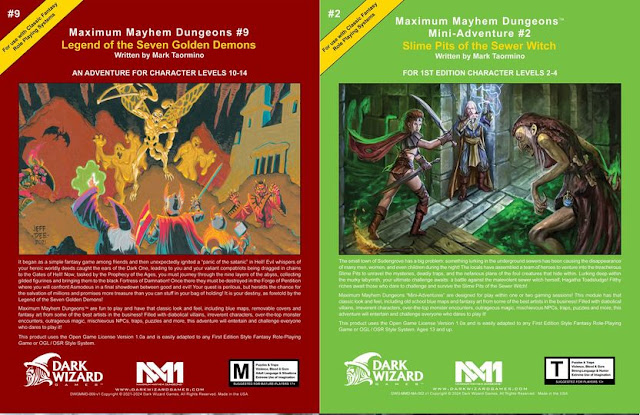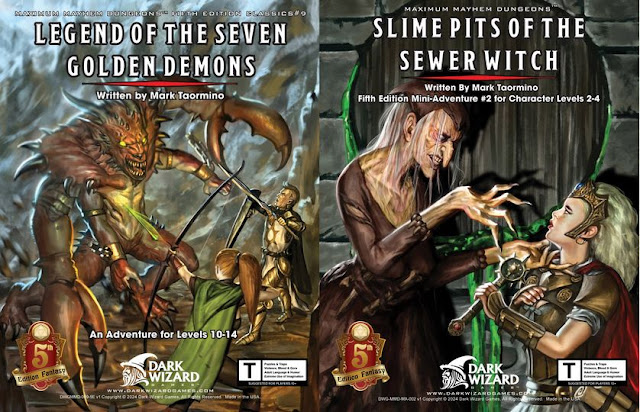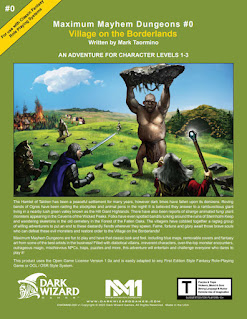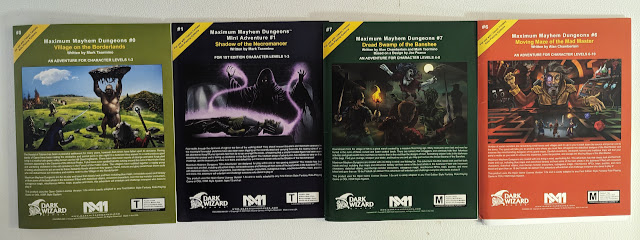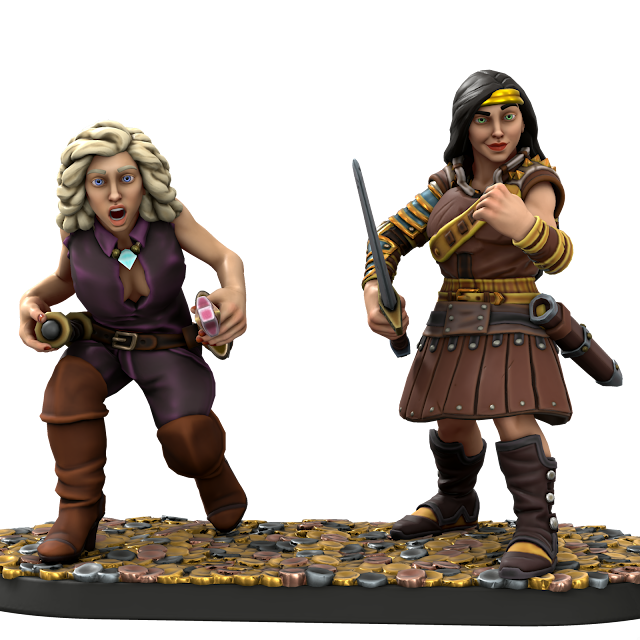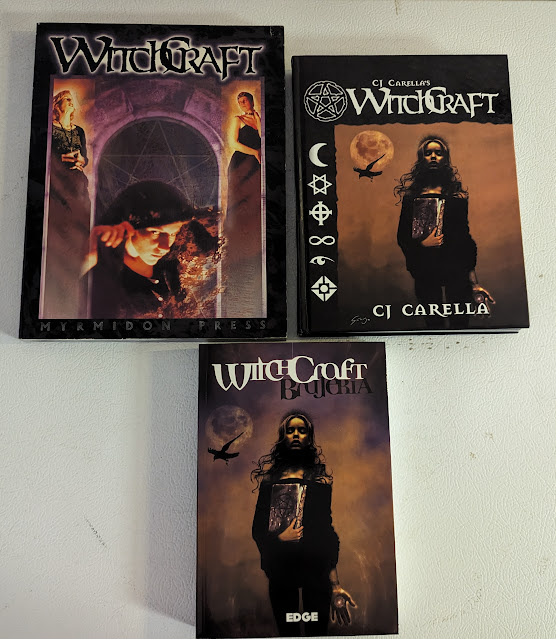I am going a little out of order today with my Forgotten Realms reviews. I still have one (or two) 1st Edition products to review, but I wanted to cluster these three together—all three, not my originally planned two—since I am opting to add in a PDF when my original plan was only to review items on my shelf. So, I am breaking all my rules in one post. It does tie into the mini-city adventure I did with them this weekend.

Given some recent movie announcements, I could not help but popping in my well-worn soundtrack to "The Crow." Every city in the 90s was dark and rainy.
I also want to state that NONE of these products were what I once thought they were and I often mixed them up.
 FR1 Waterdeep and the North
FR1 Waterdeep and the NorthDesign and Development: Ed Greenwood, Product Coordination: Jeff Grubb, Editing: Karen S. Martin, Cover Art: Keith Parkinson, Interior Art: Chris Miller. Maps: Frey Graphics and David Sutherland, Heraldic Escutcheons: David E. Martin, Typography: Kim Janke, Keylining: Stephanie Tabat.
1987. PDF, Full-color covers, and maps. 78 pages.
I am basing this review on the PDF from DriveThruRPG only. If I can find a good copy (game store auction tomorrow night!) then I will grab it. And this is one where the boxed set would be nice to have.
This is the first proper Forgotten Realm reference, with the Moonshaes the second.
You might have noticed that I listed everyone involved with this product above. The Realms, in this iteration, has become a joint effort. Yes, Ed Greenwood is the father to this brain child of the Realms. He has suitably impressed me here and in the pages of Dragon Magazine. Ed's position here is solid and secure. But if "it takes a village," it takes much more for a city like Waterdeep. Even *I* know about Waterdeep, I still call myself a novice here.
This book introduces us to Waterdeep, the "City of Splendors", and the surrounding countryside of "The North."
It is a good introduction really, starting with Chapter 1: An Introduction to the North. The surrounding lands are detailed. While I knew of some of these, this put them into better relationship with each other. For me? I like having a map open to see where I am while reading. There are no maps of this area in this product. Not a huge deal, really, since they are with the Forgotten Realms boxed set. But a small one might have been nice, at least of the area in question. Thankfully there are also plenty of good maps for this area online.
Chapter 2: An Introduction to the City of Waterdeep, takes us to the City of Splendors. We get some history, some names of important people, and (most importantly to me right now) the city's legal code.
Chapter 3: The City Wards divides the city up into various wards. As a Chicagoan, this makes a lot of sense, and I am sure to anyone that has ever lived in a good-sized city, it will as well. I will point that while this is all about Waterdeep there is an assumption here that you can use this information to also build your own cities. Each ward has a name (Castle Ward, Sea Ward...) and various locales are mentioned. Some are just a name and what they are ("The Blue Jack," Tavern) so it leaves a lot of room to expand on what you can do with own Waterdeep. There are over 280 named locations, not counting the sewers, here. There is a lot of life here and almost none of it is detailed. YES, I mean this as a GOOD thing. I don't want the names and detailed back stories of every magistrate down to beggar orphan here. I want room to discover and grow. Give me enough and then back off.
Chapter 4: Life in the City. (Yes...Despite listening to the Crow Soundtrack, this is the song going through my head as I type this. Any resemblance between my Sinéad and Kate St John of Dream Academy is purely coincidental, I am sure.) Everything that makes a city work. Religion, money, goods and services. This is the life blood of any city and Waterdeep is livelier than most. There are notes about spending the winter in Waterdeep as well. The Forgotten Realms always says the quiet part out loud, and this is a world full of adventurers. To paraphrase the old saying, "All roads lead to Waterdeep." And while you are there, behave yourself. There is even a section on the going out at night, manners and dress. Now I want all my characters to go out an buy some nice part clothes for an after-hours party.
Chapter 5: The Guild and Factions of the City covers exactly that. Ever since Fritz Leiber (and of course WAY before) and Fafhrd and the Gray Mouser, FRPG Cities have had thousands of thieves' guilds, merchant's guilds, secret guilds, and, in a Forgotten Realms trademark, Adventuring Guilds. The guilds of Waterdeep are listed in three columns and then detailed in the next 7-8 pages. Again, there is the tacit notion here that you can lift these and use them in your own Forgotten Realms city. This becomes more implicit in future products.
Chapter 6: Noble Families of Waterdeep gives us some names and crests, the most "Greyhawk" like chapter so far.
Chapter 7: Selected Non-Player Characters of Waterdeep covers some notable NPCs in greater detail. It would not be a Forgotten Realms product without some notable NPCs.
Next are adventure hook chapters.
Chapter 8: Beginning a Campaign in Waterdeep covers exactly that. And there are some great ideas here too for such a short chapter. Though to be honest if you get to this chapter and don't already have ideas then this one won't help you.
Chapter 9: Adventures in Waterdeep is the one chapter I wanted to read the most. Chapters 1-7 are great and full of ideas, but I want to discover this city as an adventurer, not as a scholar. Back when I lived in Southern Illinois, right before I moved to Chicago, I had a map of the city on my wall. I would go over that map for hours on end just fascinated by it. When I moved to the near West Side (just a notch north of Little Italy and west of the Loop) I was surprised for how little that prepared me for all of it. The City is a living place. Chicago is. New York is. And so should Waterdeep.
There are seven "mini" adventures here. I ended up using none of them!
After this (what would have been the inside covers), there are maps of the major wards and a large piecemeal map of the city for the next 10 pages. Yes, I could print them out, but I am holding out for now.
This is not the final nor most authoritative word on Waterdeep by any stretch. It is a start though and a good one.
The next two products should have probably swapped names.
 City System
City Systemby Ed Greenwood and Jeff Grubb, Editing: Karen Boomgarden, Typography: Betty Elmore, Cover Art: Larry Elmore, Keylining: Stephanie Tabat, Cartography: Dennis Kauth and Frey Graphics.
1988. PDF and Print on Demand. Full color covers and maps.
Again this one takes a lot of work from a lot of people. This book follows quickly on the heels of FR1 Waterdeep and the North. It was a boxed set, but for this review I am considering my PDF and Print on Demand versions from DriveThruRPG.
There is some repeated information in this set from the Waterdeep set. For example the entire legal code on Page 7 of this product is the same to the one in FR1 Waterdeep and the North starting on page 18. I am not 100% sure if I mind this though. I mean in truth back in 1988 this might have bothered me, but now? Well, I have the PDFs I could print them out and put them into a big binder called "Waterdeep" and organize how I see fit. I might do that in fact.
This book is more like a tourist directory to Waterdeep. The laws are discussed, the buildings are numbered and given a name. The BIG attraction to this set are the maps (which are printed here and given as a separate ZIP file.) Well, the Larry Elmore cover is striking as all hell to be honest.
If you like random tables then this is your book. Lots of tables on encounters, goods, items gained from pick-pocketing, and more.
Ignoring the use of this as an independent product it makes for a great addition to FR1 Waterdeep and the North. The two together would be a perfect product really. Looking ahead to my other Forgotten Realms books I see I don't actually have a giant map of Waterdeep. Should I rectify this? The maps in this product are gorgeous, and it would be worth my time, effort, and money to get them combined and professionally printed. Or burn through my printer ink to do it on my own and mount them to some cardboard with Scotch tape. Depends on how much I end up playing here. If I don't, it certainly will not be for lack of options!
 FR8 Cities of Mystery
FR8 Cities of Mysteryby Jean Rabe. Art Larry Elmore (cover), Dennis Kauth (buildings), Christopher T. Miller (interior art). Editing Kim Mohan. Product Manager Bruce Heard.
1989. Boxed Set and PDF. 64 page book, 2 large 25mm compatible maps, 4 6-page card stock buildings.
This is a fascinating product, and there is a lot going on here. I am reviewing my boxed set for this. There is a PDF and a softcover Print on Demand from DriveThruRPG as well.
What do I love about it? Well, for starters, that Larry Elmore cover is one of my favorite covers of all time. Really. I love how if looks and while the old adage is true, this cover made want to buy this product. When my old DM and I talked about our "Urban Survival Guide," this was the cover we thought about.
Also it came out in the liminal time between 1st Ed and 2nd Ed with a note on the cover that is was compatible with both. That is not entirely true. It is broad enough to be compatible with ANY fantasy RPG that has a city. There are almost no game stats here save for the adventures at the end.
In truth this product should have been called "City System" since that is what it is. This not about Waterdeep except in the most broad of terms.
The first part is a 64-page book that covers all sorts of details on building your city. This includes details like where it is (and how that changes the city), how big is it, taxes, defences, the government. Everything that was laid out for you in the Waterdeep and the North and City System sets are now up to you to figure out.
There is also a section how make Characters work in a city based adventure. Honestly that would have been the gold right there.
The rules are put to use in Sauter, City by the Sea, and there are five mini-adventures to help the DM and Players along. Honestly I want to run the Maltese Roc based on the name alone.
If that were all then yes, this would be a fine product. Not great, but added to the Waterdeep and the North and City System books it would make a great trilogy of playing in the city (sounds like a Stevie Wonder album). But that is not all there is.
There are two large double-sided maps for 25mm scale minis and four packages of 6-page cardstock building to build.

Since it is a boxed set, I am also keeping duplicates of old Dragon magazine articles about cities in it.
This is from 1989. D&D would not get this mini-focused for another 11 years. And it all still works with any edition you care to play with it. I read that this was going to be the first of some similar products to expand the cities even further. But honestly I am not surprised that there were not more. This looks like an expensive thing to make.
 Sinéad
Sinéad encounters
two desperate thievesFor the PDFs you would need to print out the maps and buildings to build them. I would glue them to some cardstock or print them on cardstock if your printer can do that. The advantage of the PDF and this system? As long as you can print, you can have as many of these buildings as you need.
Looking at All Three City Sets
FR1 Waterdeep and the North, City System, and FR8 Cities of Mystery are all great for that late 80s feel of the Forgotten Realms AD&D.
While each product is good individually and does what it sets out to do, one of the others points out its minimal shortcomings. Combined, they work fantastically together. So well, it makes me wonder whether I even need to leave the city!
Regardless of what city in the Realms becomes my home base (I am still partial to Baldur's Gate, but Waterdeep might win me over) I have the tools and the means to expand on it all.
Ill Met in Waterdeep
So, for my first foray into Waterdeep, the characters were all arrested. No "we met in a bar." It is "we met in jail." Sinéad, Arnell, and Rhiannon meet up with Nida (I wanted her introduction to be memorable), Jaromir, and Argyle. Who are these characters? Well, Nida, I have talked about already. Argylle is my experiment on having a character from another world end up in the Forgotten Realms. In this case a Dwarf from Rockhome, aka Mystara and the D&D B/X set. In his world his class and race is Dwarf. Here he is now a Dwarf Fighter, but I started him off as a BX Dwarf. My oldest loved that since he is playing an alternate game with his groups using D&D Basic.

Jaromir is my first real barbarian character ever. I will full admit I am playing him like I played Minsc in Baldur's Gate 3. In the video game Minsc is a Ranger, but I always gave him levels in Barbarian. Jaromir is my Minsc stand-in. Big, dumb, blonde, but a heart of fucking gold. He is so very different than anything I have ever played before. Well...he is Rashemi (like Minsc) and he is on his Dajemma. But he set out without a witch (I have no idea why yet; I only recently learned about Dajemma), so he has decided that Rhiannon MUST be his witch. Which gets him fighting with Arnell, who turns into a wolf. Nida is there picking pockets in the ensuing chaos (gotta use those tables!) and the lot of them get thrown into jail.
Since I am moving ahead in time with my reviews I also opted to use the revised AD&D 1st Ed sheets here. Except for Argyll's he has a Basic Sheet.
I wanted to get a bit further than that, but this is where I am now. I know that the characters are bailed out by a minor magistrate named Eldrith Dunslaughter, a rather pompous and unpleasant human with designs of his own. I also know the characters need to work together to find a minor stolen item called the "Stargazer's Compass," which he claims was stolen from his own collection. I have my doubts it was his. (note: no idea if this is related to the MTG item of the same name. No one here plays.)
Find the compass, and their debt to society is paid. Fail? Well, there is always community service.
Hope to learn more soon!
If you like cities and the Waterdeep in particular I highly recommend checking out Oneiropolis, the new Patreon site from game designer Joseph D. Carriker. He was the one who helped me bring Garnet to life in Blue Rose, and now he is taking his skills to a wider audience. Well worth checking out.
 "Rübezahl" by Moritz von Schwind (1859) I am working on a post for tomorrow, and while doing some reading, this guy came up. Since I am still in the middle of editing the "F's," I figure I might as well add him.
"Rübezahl" by Moritz von Schwind (1859) I am working on a post for tomorrow, and while doing some reading, this guy came up. Since I am still in the middle of editing the "F's," I figure I might as well add him. 









